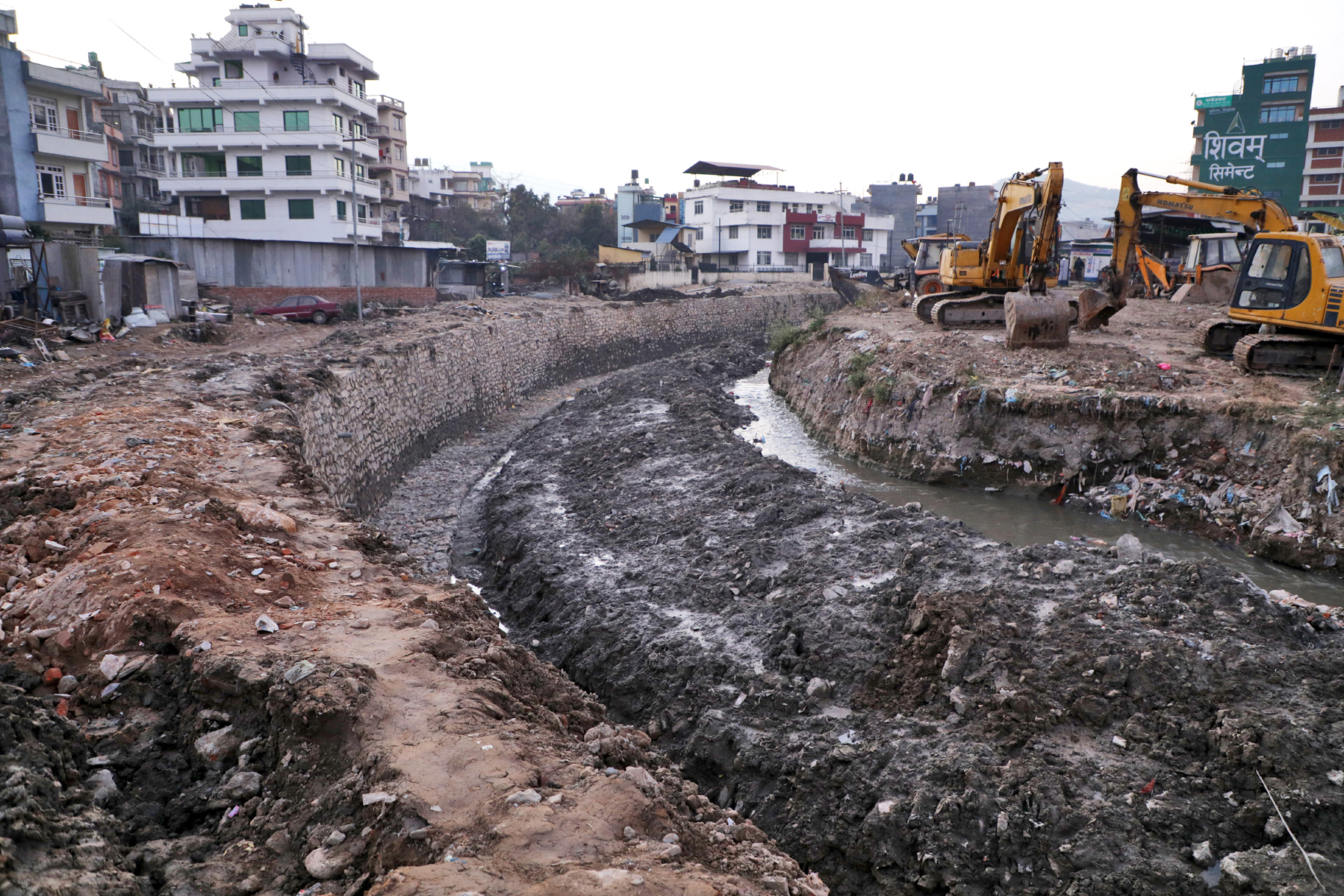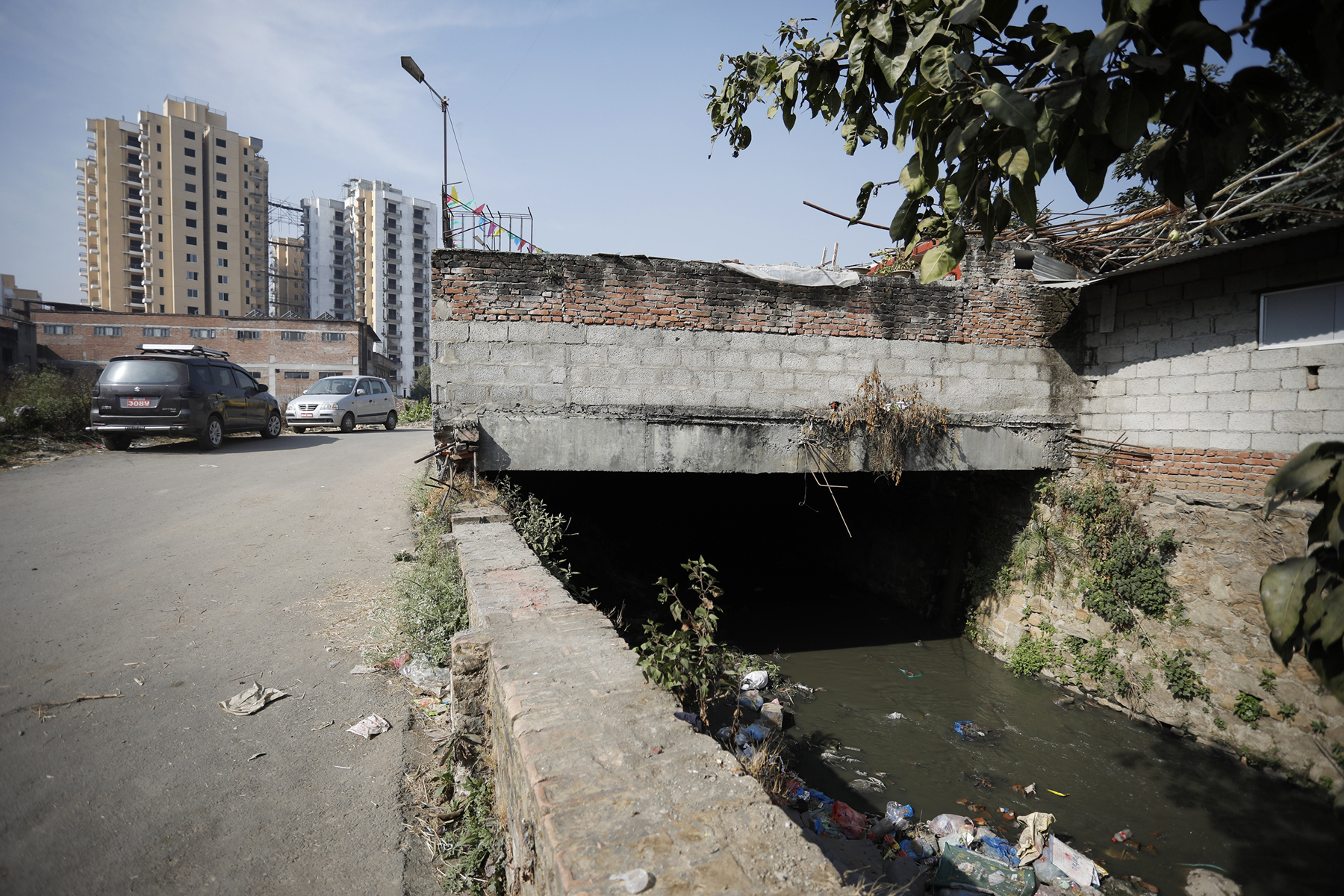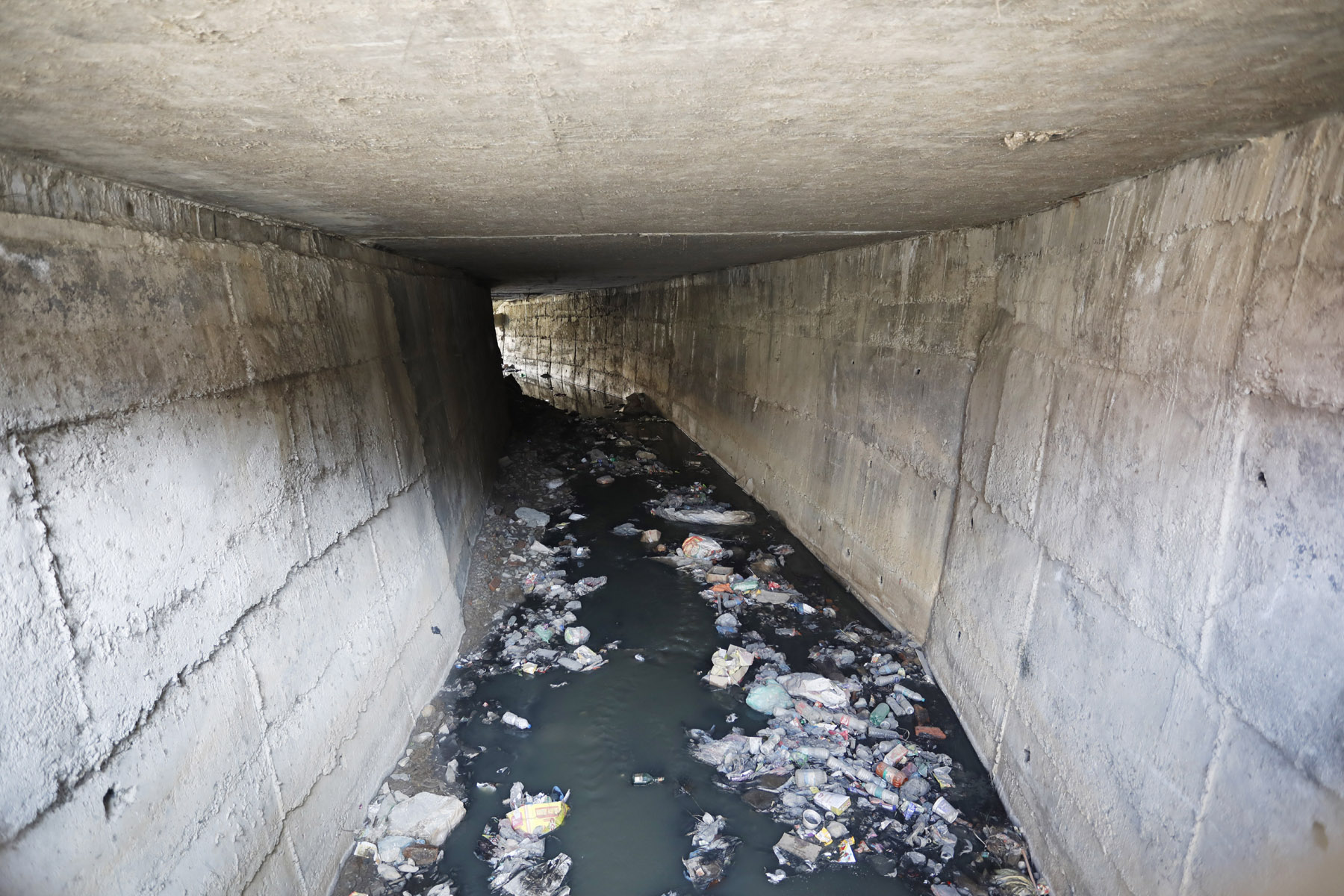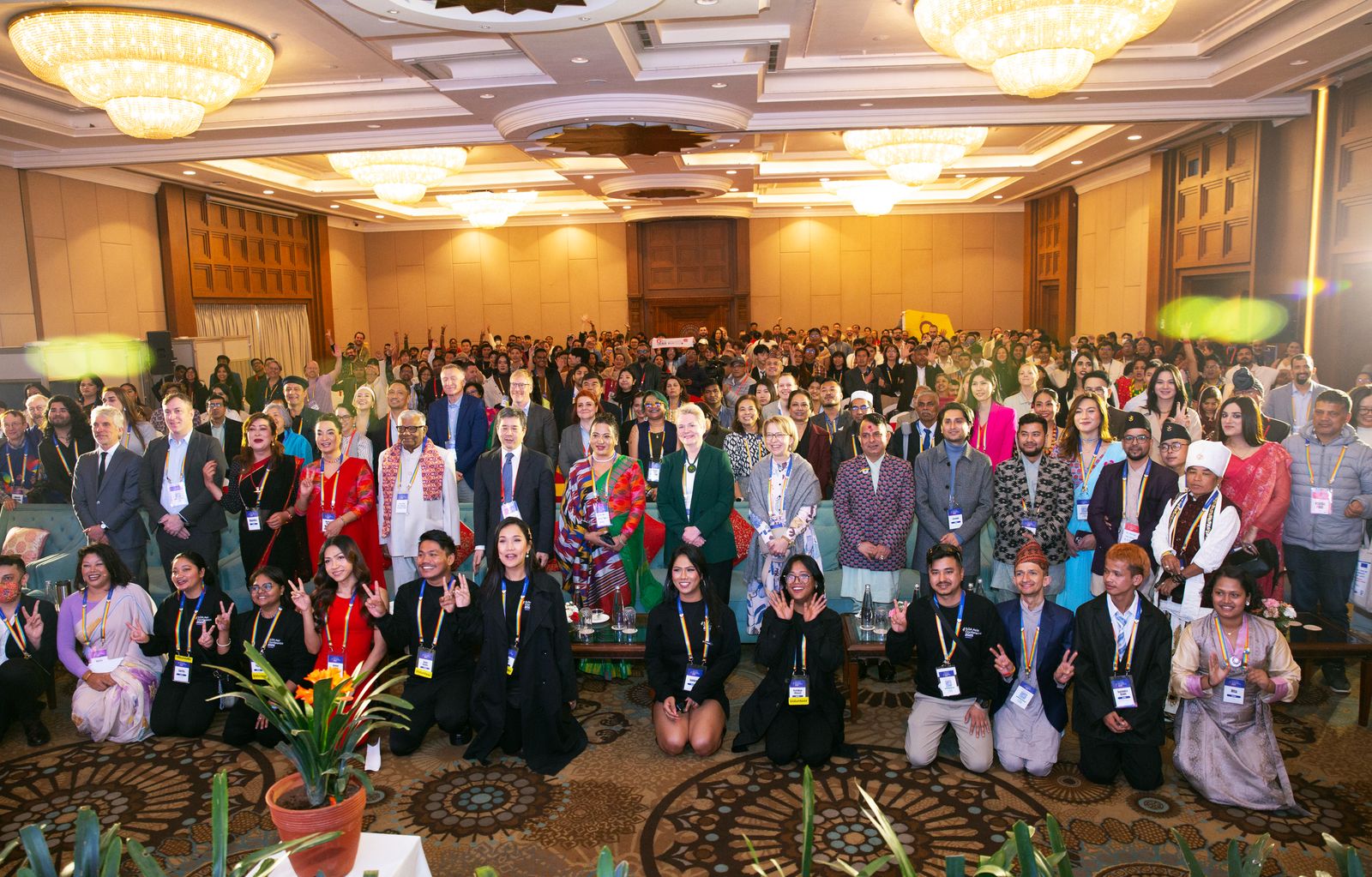Valley
Kathmandu’s rivers are becoming violent—and are gradually vanishing
Buildings and roads have encroached on the floodplains and banks of the Valley’s rivers and every monsoon, the rivers rise to take revenge.%20(1).jpg)
Srizu Bajracharya
As Hira Devi Shrestha took her usual route to the Janapath Secondary School in Kalanki, she could see the Balkhu Khola swelling from the rains that had continued since early morning. The rush of the river looked more violent than on most days, but since the river always looked angry during the monsoon, she carried on.
Shrestha parked her scooter by the riverside, like she always did, and went into the school, not thinking twice about the river. But a little past 10am, when Shrestha looked out, her scooter had disappeared--the waters from the river had swallowed it.
By 11:30, the school had sent all its students home. There was no one left at the school besides the teachers and administrative staff.
“We hadn’t imagined that the river will come to us. We thought the waters would subside soon,” said Shrestha.
By afternoon, the waters had engulfed the first floor, and as the downpour persisted, people started to panic. “It seemed like the end for us. There was water everywhere and we didn’t know from where to get out,” said Shrestha.
The flash flood subsided seven to eight hours later, but by then, one resident had already died and the river waters had already inundated more than four hundred houses, according to Sobha Sapkota, chairperson of Kathmandu Ward 14.
This wasn’t the first time that the Balkhu river had flooded, but in July 2019, locals were as unprepared as they were in 2018. Only this time, locals knew why.
Over the years, industries, institutions and residential colonies had sprung up on the banks of the river, increasingly constricting the river’s passage. The premises of these buildings were paved over, creating impervious surfaces incapable of absorbing rainwater, leading the waters into the river and increasing its flow.
“The river didn’t come to us, we went to the river. This probably wouldn’t have happened if the plotting of land in the early days had considered the river’s waterway,” said Sapkota. “Now we are in the river’s way and recurring floods have become a reality.”
In 2018, the river inundated many squatter settlements and private properties in the Balkhu area. Almost 20 houses were flooded. In 2002, the river destroyed a garment factory on the Balkhu corridor. And in the monsoon flood of 1954, a flood took the lives of two people and damaged several properties.
Every year, there are consistent floods across the breadth of the Kathmandu valley. Almost all of the Valley’s countless rivers, streams and rivulets have been encroached upon. And every monsoon, these rivers rise to exact revenge on those who have forced these open meandering rivers and their floodplains into narrow gullies with barely any bend to them.
Riverfront construction

Since the early 1990s, the Kathmandu valley has undergone immense changes. Increasing migration from across the country has necessitated new homes and buildings. The Valley, according to research, is one of the fastest growing urban agglomerations in South Asia. Alongside urban sprawl into the foothills, the core city areas have densified, placing Kathmandu among the most densely populated cities in the world.
According to one 2019 study, slum dwellings on the banks of the Bagmati river at Thapathali began to emerge in the late ’90s. These dwellings took over the traditional ghats that once lined the river.
“If you look at the Bagmati promenade, there are wells built near the stairways of the ghats to preserve water in reservoirs during incessant rain. But over the years, these ghats, which are boundaries for the rivers, have been encroached upon and these wells are no longer in use,” said Narendra Shakya, a professor of water resources at Pulchowk Engineering College.
According to Madhukar Upadhyay, a watershed expert, when the flow of rivers like the Bagmati dries during the winter, human settlements are quick to occupy the floodplains vacated by the river.
“But they don’t realise that the rivers might come back again,” he said.
These lands are cheap too, because they belong to the river and are generally sold illegally by unscrupulous middlemen.
“The cheapest lands are near the riversides,” said Upadhyay. “Before, it was just a few houses, but when big industries and schools started converting those lands, their economic value improved, and with them, the whole area became commercial.”
Now, when Kathmandu receives incessant rain, many towns are inundated with water that overflows from the banks of the rivers. The same thing happened with the Balkhu river: the river devoured the settlement.

In another part of the city, the Manamati river, in Kalimati, has also been causing flash floods every monsoon. Many locals believe that primary reason behind the floods is a concrete jacket bridge constructed over the river in Kalimati.
The bridge, which is about 100 metres long, was built to join two neighbourhoods, wards 13 and 14. But many houses in the area have also cornered the river with tall walls that mark the frontiers of the neighbourhood.
The community that lives closest to the river believes that the construction has actually protected them from the floods that happen every year.
“The construction has helped the community immensely--there is less stench from the river, and we don’t have to worry about floods anymore,” says Dharma Narayan Maharjan, a local who lives near the concrete bridge that spans the Manamati.
However, for many years, ever since the construction of the concrete bridge, water from the Manamati has engulfed many parts of Manamati marg, Wal marg, Chinna Lata marg, Gautam marg, and some homes near Soaltee Mode, said Bijaya Manandhar, a resident of Ward 13.
“Manamati, instead of flowing its course, surges down to our area. At first, we didn’t know why this was happening, but when we realised it was because of the new concrete bridge, many from our community asked that it be taken down,” said Manandhar.
Following their complaint, the Kathmandu Metropolitan City had asked the executors of the jacket construction to explain their actions.
However, five years since, nothing has been corrected, says Manandhar. There has been no government initiative to mediate the problem the communities have been struggling with.
“We didn’t come up with the road construction, somebody else did. And it is not our job to stop the construction that a landowner plans for--that is something the government needs to do,” said Lal Prasad Gauchan, chairperson of Dhabagg Marg Tol Samittee in Ward 13.
.jpg)
Laws and regulations
According to the old Kathmandu building code, major rivers like the Bagmati, Bishnumati and Manohara need at least 20 metres of a free floodplain area on both sides to provide the river with unobstructed space to flow. Small streams like the Manamati, on the other hand, should have a free area of at least six metres on both sides. Likewise, the Balkhu Khola should have at least 10 metres of space on each side of the river before settlements start.
However, as is evident, this code has been consistently violated and river floodplains have been widely used for settlements.
Even the High Powered Committee for Integrated Development of the Bagmati Civilisation, which oversees the beautification of the Bagmati river, has purchased land near the river to build corridor roads. But the material for the roads--concrete and coal tar--however, are not suitable for river ecosystem, say river experts. And these roads themselves do not permit enough space--20 to 30 metres--for the river.
“The government’s plan sounds good to people, as roads provide access and embankments protect humans from the river,” said Upadhyay. “But no one has yet thought about the future.”
Because when roads or settlements are built alongside the rivers or on their banks, water gets forced into a narrow pathway, which increases the speed of the water.
The new building code further states that rivulets cannot be covered and strictly prohibits encroachment of rivers, streams, lakes, ponds and canals and says structures can only be built 30 metres away from the river area.
But at a relatively new settlement in Sitapaila, across the Buddhapark in Swayambhu, an entire river called the Bhachaa has been covered with a concrete roadway. Naresh, a local resident who asked that he only be identified by his first name, told the Post that every monsoon, the place is swamped with water.
According to Upadhyay, the encroachment of rivers is rampant because there is no proper policy or government body that protects the rivers.
“There is no government body that works to protect the river; the ones that exist only manage water for irrigation and other processes,” said Upadhyay. “And the laws have been violated by everybody, not just one person. When a whole community is involved, who will speak for the river?”
And land encroachment is not visible in maps, says Damodar Dhakal, information officer at the Survey Department.
“We can only identify encroachment when someone files a complaint,” he said. “That’s why there are houses near the river areas.”
In Bhaktapur, almost every year, rain swells the Hanumante river, one of the main tributaries of Bagmati river, causing numerous flash floods. According to urban planners, the floods in the area are the repercussions of human encroachments on the rivers’ floodplains.
“As floods become a reality, people only think of how to protect themselves from the river. But the river is not going to respect that. The next time there is a big event, the river will take its own course,” said Upadhyay.
In July 2018, a flood on the Hanumante river damaged property worth Rs119.35 million in Bhaktapur. In the monsoon of 2016, the river inundated settlements at Sallaghari, Nayabasti, Siddhi Memorial Hospital and Radhe Radhe in Madhyapur Thimi. And in 2015, a flash flood submerged the settlements of 850 earthquake victims.
The concretisation of rivers

According to river experts, when the use of concrete increases near the rivers, it disrupts the entire ecosystem. During rain, river beds allow water to percolate, which they slowly release, contributing to the river’s perennial flow. However, with sewages and concrete disrupting the seepage process, rivers are unable to imbibe water to sustain during the dry season.
“There is either too much water or there is no water at all,” said Shakya, the water resources professor. “This shows how unplanned our development is.”
Rivers support ecosystems but they also support human life. It is through rivers that many springs get their water. But in cities like Kathmandu, the connection people once had with rivers is being separated, and encroachment is increasing.
“At present, we have no direct relation with our rivers. We even buy water in jars and tankers and because of this, people have not realised what happens when rivers dry up,” said Upadhyay.
Even the religious and cultural significance of taking a holy dip in the cleansing waters of a river has ceased, diminishing their value.
In Kathmandu, there is a seemingly incongruous process at work-- many rivers are disappearing but the rivers that remain are flooding. The water level of the Tukucha river, one of the important tributaries of the Bagmati, depletes profoundly after the monsoon is over. This river, which originates in Maharajgunj to join the Bagmati at Kalmochan, has all but disappeared. For many locals, the river only comes into existence during the monsoon.
“When small tributaries dry, people may not see it as a problem, but eventually, this will grow into a bigger issue,” said Upadhyay. “There might come a time when there won’t be any groundwater remaining.”
But Upadhyay believes that eventually the rivers will find a way and when they do, it will be humans who pay the price.
“We may not see it, but their natural process is continuing. After all, it is the process of the river coming down from the mountains and changing paths that creates landscapes,” he said. “If they need to, they will take their bends and they will break walls.”
Meanwhile in Balkhu, as another year begins, residents are anxiously overseeing the government’s construction of corridor embankments. Many Kalanki locals who were affected by the flood last year believe that the water may have surged into the city because of the concrete walls built around the Kirtipur area.
And with monsoon less than six months away, locals are praying for the rain to be humble this year.
“The downpour was ruthless last year, but this time we are better prepared,” said Sapkota, the Ward 13 chairperson. “We have already started constructing walls near the river.”
***
What do you think?
Dear reader, we’d like to hear from you. We regularly publish letters to the editor on contemporary issues or direct responses to something the Post has recently published. Please send your letters to [email protected] with "Letter to the Editor" in the subject line. Please include your name, location, and a contact address so one of our editors can reach out to you.




 13.12°C Kathmandu
13.12°C Kathmandu





